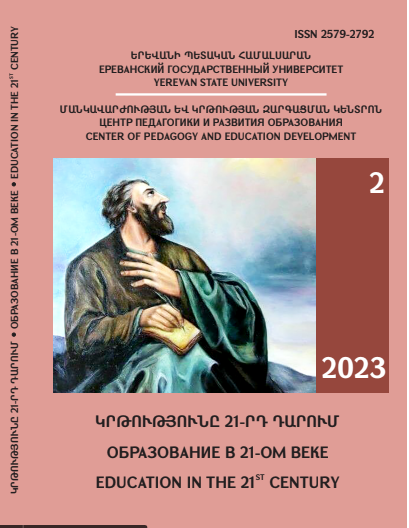COMPARATIVE ANALYSIS OF SYSTEMS OF HIGHER EDUCATION MANAGEMENT IN REPUBLIC OF ARMENIA AND BULGARIA
DOI:
https://doi.org/10.46991/ai.2023.2.241Keywords:
higher education, governing bodies, admission, evaluation, Bologna declaration, universitiesAbstract
Our article is dedicated to an in-depth examination and comparison of the higher education systems in the Republic of Armenia and Bulgaria. We will consider their distinctive characteristics within the realms of education, admission procedures, and other aspects related to governance, funding, and organizational structure. The article will also highlight optimal approaches and strategies for enhancing educational standards and achieving greater efficiency through various reform initiatives.
The primary objective of this article is to meticulously investigate the higher education systems in Armenia and Bulgaria, conducting a comprehensive comparative analysis that unveils their commonalities and disparities. The findings from this study will be presented in a series of tables to facilitate a clear distinction between the unique features of these two nations' higher education landscapes.
Through our comparative analysis of higher education in Armenia and Bulgaria, we have reached the following conclusion: Both countries manage their higher education systems through state and intra-university levels, with oversight from central and local governmental bodies, albeit under differing nomenclature. Additionally, both nations are active participants in the Bologna process, though Bulgaria ratified the Bologna Declaration in 1999, whereas Armenia did so in 2005.
Furthermore, both Armenia and Bulgaria have a mix of state and privately licensed universities. Armenian higher education institutions encompass universities, institutes, Academy of Science, and conservatory, whereas in Bulgaria, you will find universities, specialized higher schools, and colleges.
Other distinctions within the higher education systems of these two countries include variations in admission procedures, structural arrangements, and grading systems.
In conclusion, the examination and comparison of higher education management systems in Armenia and Bulgaria provide valuable insights that can be harnessed to enhance educational quality and productivity in either nation by adopting best practices from the other.
References
Список использованной литературы:
Навоян А., Реформы образования в Армении, UNESCO, 2009г., 10 стр.
Հարությունյան Կ., Դավթյան Ն., Սարգսյան Գ, Կրթությունը Հայաստանում, Երևան, Աստղիկ գրատուն, 2003, 69 էջ
Միրզախանյան Ա., Կրթությունը, աղքատությունը և տնտեսական ակտիվությունը Հայաստանում UNDP (ՄԱԶԾ); Երևան – 2002, իրավավիճակային վերլուծության զեկույց, 96 էջ
Высшее образование в Болгарии https://allterra.ru/program/vysshee-obrazovanie-v-bolgarii/ / 25.08.2023
ЗАКОНОДАТЕЛЬСТВО БОЛГАРИИ, Закон о высшем образовании http://bulgaris.ru/AGPovishemobraz/ovishemobraz020.html /20.08.2023
Интересные и полезные публикации/Система оценок в странах мира https://vektor-tv.ru/light/sistema-otsenok-v-stranakh-mira / 22.07.2023
МИНИСТЕРСТВО ИНОСТРАННЫХ ДЕЛ РЕСПУБЛИКИ АРМЕНИЯ, Учеба в Армении, https://www.mfa.am/ru/study-in-armenia/ / 20.07.2023
Образование в Болгарии https://www.unipage.net/ru/education_bulgaria / 25.07.2023
Образование в Болгарии в 2023 году https://visasam.ru/emigration/ucheba/obrazovanie-i-obuchenie-v-bolgarii.html / 25.07.2023
Система образования в Болгарии https://zaochnik.ru/blog/sistema-obrazovanija-v-bolgarii/ / 20.07.2023
Страны Болонского процесса (Countries of the Bologna Process)
https://trends.rbc.ru/trends/education/6295da569a7947202c6b2a0f / 20.07.2023
ՀՀ ՕՐԵՆՔԸ ԲԱՐՁՐԱԳՈՒՅՆ ԵՎ ՀԵՏԲՈՒՀԱԿԱՆ ՄԱՍՆԱԳԻՏԱԿԱՆ ԿՐԹՈՒԹՅԱՆ ՄԱՍԻՆ, գլուխ 5, հոդված 24, ընդունված՝ 14.12.2004 թ. https://www.irtek.am/views/act.aspx?aid=150067&m=%27%27&sc= / 09.06.2023
ՀՀ ՕՐԵՆՔԸ ԿՐՈՒԹՅԱՆ ՄԱՍԻՆ, գլուխ 1, հոդված 3, ընդունված՝ 14.04.1999 թ. https://www.arlis.am/documentview.aspx?docID=99183 / 09.06.2023
Downloads
Published
How to Cite
Issue
Section
License
Copyright (c) 2023 Mary Avetisyan

This work is licensed under a Creative Commons Attribution-NonCommercial 4.0 International License.

